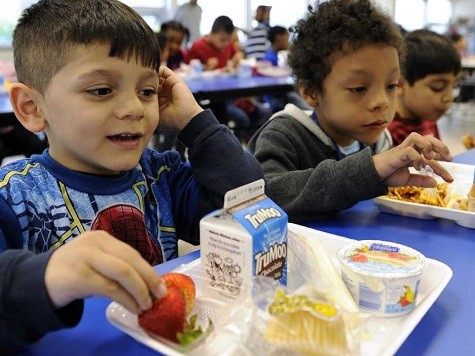In a breathless, Drudge Report-linked headline, the Washington Post reported last week that the “Majority of U.S. public school students are in poverty.”
A Huffington Post piece by Rebecca Klein, published 12 minutes earlier, sported a similar headline, “More Than Half Of American Schoolchildren Now Live In Poverty.”
The only problem with these headlines, and the stories beneath them, is that they aren’t true—not even close. Both pieces were triggered by a report from the Southern Education Foundation.
The WaPo piece, by education reporter Lyndsey Layton, said the Southern Education Foundation claimed that “51 percent of students in pre-kindergarten through 12th grade in the 2012-2013 school year were eligible for the federal program that provides free and reduced-price lunches.” Layton goes on to write that “The lunch program is a rough proxy for poverty…” with Klein similarly noting that, “Eligibility for free or subsidized lunch for students from low-income households serves as a proxy for gauging poverty…”
Except that it’s no such thing.
Having researched poverty and its root causes (it’s mainly due to a lack of workforce participation) the articles’ headlines prompted a round of fact checking with the U.S. Census Bureau’s online resources. In a few minutes of checking it was easy to see that the journalists took at face value the Southern Education Foundation’s conflation of “poverty”—which has a very specific definition—with eligibility for the federal free and reduced school lunch program, and, in so doing, more than doubled the number of children in poverty with a few clicks of the keyboard.
In 2013, some 19.9 percent of children in America were in families with income at the poverty line or below—in 2014, the income threshold was $23,850 for a family of four. (Among the native-born of all ages, the poverty rate was 13.9 percent while among non-citizens, the rate was 22.8 percent while naturalized residents had a poverty rate of 12.7 percent.)
So, how does 19.9 percent become 51 percent?
The free and reduced lunch program eligibility was $44,123 in 2014—far closer to the median family income than to the poverty line. Increasing the income threshold to 185% of the official poverty line more than doubles the population in “poverty.”
But, a few extra percent is needed to get to 51 percent in “poverty.”
That milestone was achieved by new rules for the school lunch program. The Department of Agriculture, the federal agency that administers the school lunch program, recently changed eligibility rules to reduce the paperwork required to enroll children in the program by allowing all children in a school with a majority of low-income students to qualify for the program. Thus, a few hundred thousand more children were made eligible and presto—America has a majority of public school children in “poverty.”
The punch line in both stories is that, per the interviewed experts, now that a crisis has been identified, we must do something about it.
“We’ve all known this was the trend, that we would get to a majority, but it’s here sooner rather than later,” WaPo quotes Michael A. Rebell of the Campaign for Educational Equity at Teachers College at Columbia University. Rebell goes on to say, “A lot of people at the top are doing much better, but the people at the bottom are not doing better at all.”
Government money is always at issue in reports of this nature. Not to disappoint, WaPo notes, “The new report raises questions among educators and officials about whether states and the federal government are devoting enough money—and using it effectively—to meet the complex needs of poor children.”
The WaPo story concludes with another quote from Rebell calling for the federal government to cease its focus on results in public schools and rather, focus on needs, “We have to meet their health needs, their mental health needs, after-school programs, summer programs, parent engagement, early-childhood services. These are the so-called wraparound services. Some people think of them as add-ons. They’re not. They’re imperative.”
Lastly, the problem with these stories, and most others about poverty, is that the nation’s official poverty measure neither accounts for the cost of living from state-to-state nor the value of “non-cash” assistance such as food stamps and housing subsidies. As a result, the poverty rate is overstated in the inexpensive South and Midwest and understated in the Northeast and far-West.
Further, few stories or studies adjust for basic demographics such as the effect race, ethnicity and national origin has on the incidence of poverty from state-to-state. This distortion hinders a true understanding of poverty and its causes—which, as it turns out, have far more to do with a lack of economic opportunity than with a lack of government programs and insufficiently progressive taxation as the left would have us believe.
As it turns out, for the past three years the U.S. Census Bureau has published a new, more comprehensive measure of poverty called the Supplemental Poverty Measure. Accounting for the cost of housing and the full range of entitlements and taxes, this new poverty measure shows that high-tax, high-regulation California has the nation’s highest poverty rate at 23.4 percent, a rate some 47 percent higher on a per capita basis than Texas’ 15.9 percent rate, a rate that ties the national average. Of note: both California and Texas are minority-majority states.
In all likelihood, we won’t be seeing a spate of stories anytime soon out of what the late Andrew Breitbart labeled the “Leftist-Media-Industrial-Complex” questioning poverty’s true causes, searching for a connection between poverty and a lack of economic opportunity—wondering why it is that California, with taxes at the state and local level some 52 percent higher as a share of income than in Texas has proportionately 47 percent more people in poverty?
Chuck DeVore is vice president of policy at the Texas Public Policy Foundation and served in the California State Assembly from 2004 to 2010. Follow him on Twitter @chuckdevore.

COMMENTS
Please let us know if you're having issues with commenting.